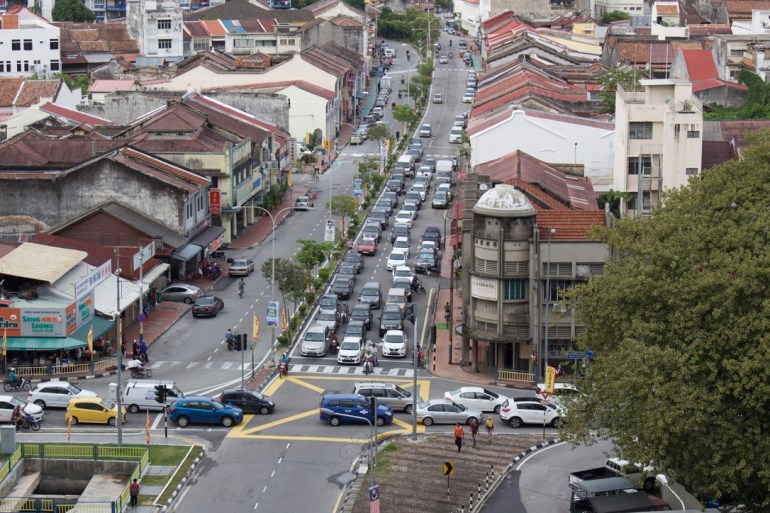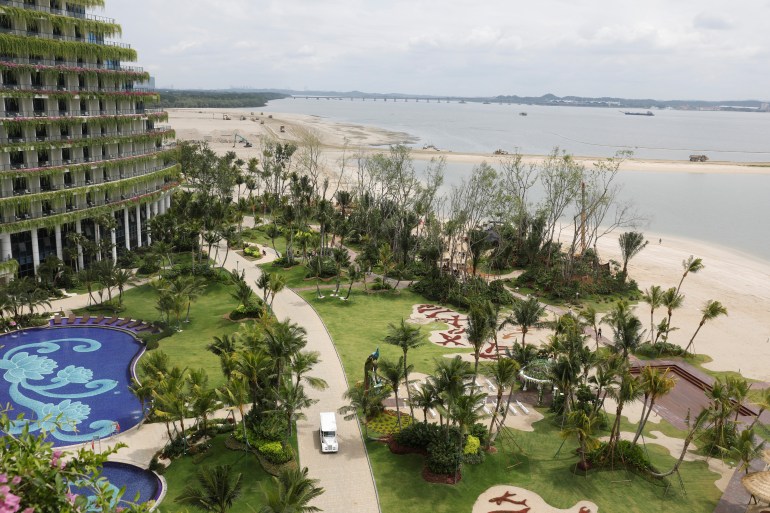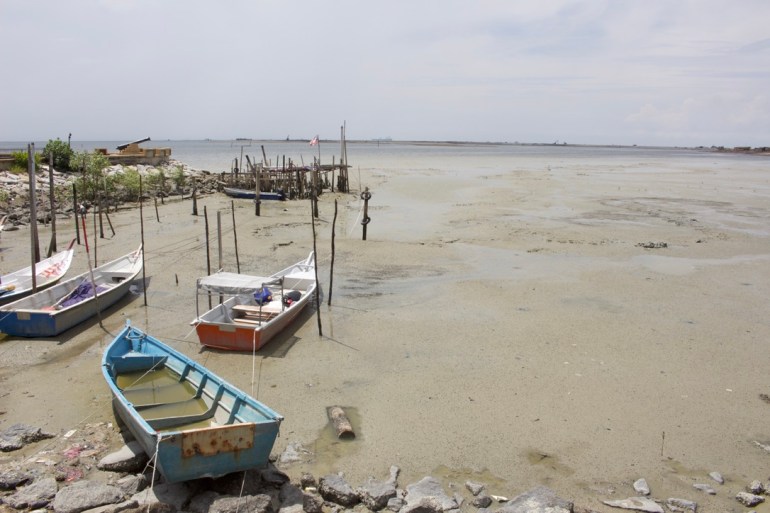Malaysia fishermen in last-ditch bid to stop Penang reclamation
Fishermen to appeal to federal government over Penang state’s plan to create three artificial islets off island’s southern shore.

George Town, Malaysia – Building three artificial islands from scratch off the island of Penang in Malaysia’s northwest is no small task. But the government of Penang, one of Malaysia’s smallest states, appears determined to take on the challenge.
Approved in 2015, the hugely controversial Penang South Reclamation (PSR) was conceived to fund the larger and much anticipated 46 billion Malaysian ringgit ($11bn) Penang Transport Master Plan (PTMP), which includes the development of a seamless system of new highways, a tunnel connecting the mainland and island and a light rail system to ease the island’s traffic congestion.
Keep reading
list of 4 itemsFantasy writer mines modern Malaysia’s cultural complexity
Malaysia’s new PM brings graft-tainted UMNO back to power
2020 was ‘deadliest’ year ever for Rohingya sea journeys: UNHCR
The project will create 4,500 acres (1,821 hectares) of land on three artificial islands which will have largely car-free housing and an industrial area built from bamboo, timber and recycled concrete for as many as 15,000 people on each island. Now touted as the main economic driver for Penang’s post-coronavirus recovery, its creators say the PSR will create 300,000 jobs over the next 30 years, reduce brain drain and guarantee a better future for Penang.
However, environmentalists say the three islands – named BiodiverCity – will bury the state’s richest fishing and most biodiverse area in the equivalent of 76,000 Olympic-size swimming pools of sand. They lie a mere 250 metres (820 feet) off the island’s southern coast. The state government claims there is no more land on the island left to develop, even though the largely flat portion of Penang state on the Malaysian mainland, called Seberang Perai, an area that is is slightly bigger than Singapore and roughly two-and-a-half times the size of the hilly island, is at its disposal.
Since the project was approved in 2015 there has been a constant tug-of-war between those concerned with the reclamation’s disastrous environmental consequences, who campaign under Penang Tolak Tambak (meaning “Penang Rejects Reclamation”), and staunch supporters of the state government who argue that the project is the only way to secure the economic growth they want for Penang.

The representatives of the affected fishing communities, led by Zakaria Ismail, the head of the fishermen’s union of Sungai Batu, plan to present an appeal to the federal government this week, asking for the project’s Environmental Impact Assessment (EIA) to be withdrawn. At the time of writing, construction has yet to start because of the coronavirus pandemic.
“My hope is that this issue is given full attention,” Zakaria told Al Jazeera. “The Environmental Management Plan report is in favour of us fishermen, and the federal government should cancel the PSR project.”
Assessing the impact
Some experts say what looks good on paper may not be the wisest choice for Penang’s future.
The dredging and sand mining work required over more than 20 years of reclamation works will “translate into undersea habitat destruction, hindrance of fish migration, impacts on food web structure, and oxygen depletion,” Penang-based environmental and urban policy researcher Evelyn Teh told Al Jazeera. The damage will also affect the neighbouring northern coast of Perak state and the fishing communities in that area. The cost of the project is also concerning: according to the Penang Forum, a coalition of NGOs opposing the PSR, its original 2015 plan for the two islands was an estimated eight billion Malaysian ringgit ($1.9bn). In 2021 that rose to seven billion Malaysian ringgit ($1.7bn) for just half of one island.
A joint venture between the state government and SRS Consortium (a group of Malaysian companies led by construction giant Gamuda with a controlling 60 percent stake), it wants to fund the reclamation costs by selling the land on the first artificial island to the highest private bidders. SRS will retain a 70-percent share, the state government only 30 percent.

Lim Mah Hui, an economist and former Penang Island City Councillor now with Penang Forum, calculates that under these conditions, the state government will only be able to earn about 600 million Malaysian ringgit ($145 million) in the next 10 years – one-tenth of the expected investment for its transport ambitions.
On June 24, Lim told local broadcaster Astro Awani that Penang Forum did not object to the state’s development as long as it was done sustainably. But the PSR seems to have mutated into a mega construction project, he said. Lim also said that the PSR’s 1,000-page environmental impact assessment failed to consider alternatives to reclamation, such as building an equivalent development on the mainland of Penang state. He said the construction will permanently transform the area’s coastal mudflats.
Six years ago, the Penang Forum proposed an alternative to the PTMP. The “Better, Cheaper, Faster” proposal suggested a less damaging approach built around the Autonomous Rail Rapid Transit (ART), a system of trackless trams that would cost less than 10 billion Malaysian ringgit ($2.36bn). “Sarawak and Johor states went ahead, but we didn’t,” said Lim, referring to two other states in Malaysia.
Hot-button issue
Earlier in May, Nurul Izzah Anwar, the daughter of opposition leader Anwar Ibrahim and a member of parliament for the mainland Penang constituency of Permatang Pauh, was the first member of a party within Penang’s ruling Pakatan Harapan (PH) coalition to voice her opposition to the project.
Her main concern was that the PSR would take considerable resources and focus away from the country’s coronavirus fight and much-needed development on the mainland.
“The ongoing political dynamics in Malaysia have caused opposition state governments [like Penang] to rely heavily on monetising natural resources, that is, existing or reclaimed land,” Nurul Izzah told Al Jazeera. “In Penang and other states, we see an unsustainable trade-off between limited state finances and the environment.”
Ministers in the federal government, which is made up of the rival Perikatan Nasional (PN) coalition, have also described the project as unnecessary and unsustainable. But as an opposition-run state with limited financial support from the federal authorities, selling land is one of the few ways for the state to raise funds.
Penang Infrastructure and Transport Committee Chairman Zairil Khir Johari says it is little more than political bullying. “They do not appear to have any qualms whatsoever towards the reclamation projects in PN-led states such as Kedah, Johor, Terengganu, Kelantan and Melaka,” Zairil wrote on his blog.
The most controversial of the projects in Malaysia are Chinese-backed: Forest City in Johor, which has been criticised for its effect on fisheries, seagrass beds, mangroves and relations with neighbouring Singapore; and the Melaka Gateway, a port and cruise terminal that was part of China’s Belt and Road initiative but was halted on November 16 last year without explanation.


The project left behind banks of reclaimed sand along the coast of the city, which, like Penang, is a World Heritage site. Citizens are also opposing the Melaka Waterfront Economic Zone, a 22-kilometre-long (14 miles) reclamation project that puts the state’s last beach and main fishing ground at risk.
Zairil, whose Penang island constituency of Tanjung Bunga often faces flood and landslide problems from hillside development, insists the state government needs to find suitable reclamation sites around the island to ensure its future economic development. Zairil, says Penang wants jobs, not another Forest City.
The PSR area was “no Great Barrier Reef”, he added, but “shallow, muddy water” (a claim that was immediately refuted by experts) that could be easily sacrificed for the sake of economic development.
Zairil’s latest statements seem to contradict the state government’s earlier stance.
In November 2018, only a few months before Malaysia’s second IKEA outlet opened in a new development area in Batu Kawan on the mainland, Penang Chief Minister Chow Kon Yeow was quoted by The Star newspaper as saying that the area has a lot of potential to attract investors.
“It is not true that there’s no more land for development in the mainland,” Alan Teh told Al Jazeera. Teh is the founder of Atelier Alan Teh Architect and often oversees projects in mainland Penang.
“The state government has been expanding its industrial land bank [on the mainland] at Batu Kawan due to overwhelming demand. Logic tells me that it is cheaper, faster and more sustainable to acquire or convert privately owned agricultural land into development land, and the state government has the power and right to convert or increase the land use ratio (by plot ratio or density) for areas earmarked for special state initiative projects,” he said.
Learning from past mistakes
Penang should understand the risks of reclamation and mega projects very well even without looking at what has happened in Melaka.
Started in 2006, the Seri Tanjung Pinang (STP) 1 land reclamation project created 240 acres (97 hectares) of land off the island’s north coast to build some of Penang’s most luxurious properties. A second 760 acre (307.5 hectare) site is currently being built with 131 acres (53 hectares) set aside for the Penang State Government.
But by 2018, local fishermen lamented that the once plentiful fish and crustaceans had disappeared. And since September 2019, before the COVID-19 pandemic changed the pace of life and business, the promised developments stalled and remain unfinished.
Zakaria said that even when Penang completed construction of its second bridge link to the mainland in 2014, sludge from underwater drilling affected water turbidity and reduced the fish population for the following five years.
He added that works towards the PSR could mean the end of Penang’s fresh seafood supplies.
“The state government must ensure that there is enough food for the people of Penang because unbalanced development will result in excess money, but insufficient food,” he said.
The Penang state government has promised the fishermen a one-off compensation of 20,000 Malaysian ringgit (about $5,000), and either guaranteed employment throughout the decade-long reclamation or an upgrade to new boats and engines.
It has also said it will build new jetties to help fishermen go out to sea even at low tide. But few feel it will be enough for the uncertain future they now face.
“Who do these megaprojects benefit?” asked Teh, pointing out that past reclamation projects on Penang island have offered very limited recreational space for the general public. “Only the state and the super-rich, at the expense of the environment and lower-middle-income group, who lose their livelihoods due to the reclamation projects.”